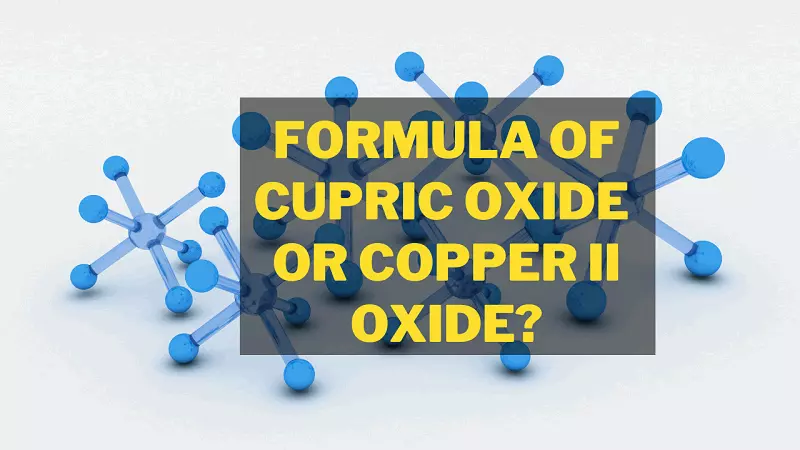
Formula of Cupric Oxide or Copper II Oxide | Uses & Applications
What is the formula of Cupric Oxide or Copper II Oxide?
Cupric oxide, also known as Copper II oxide, is composed of Copper atoms and Oxygen atoms . Indeed, the term oxide is generally used to designate compounds which contain oxygen. The formula of cupric oxide (Copper II Oxide) is CuO. The Copper (Cu) atoms and the Oxygen (O) atoms are then represented in equal proportions.
In cupric oxide the element Copper is found in its Oxidation +II (Cu2+) state. Also please remember that the mention of the number "II" is important, because there is also another Copper Oxide: Copper Oxide I (simply called Copper Oxide), with the formula Cu2O, in which the element Copper is found in its Oxidation +I state.
Properties of Cupric Oxide
Physical properties of cupric Oxide
- Cupric Oxide has its CAS number: 1317-38-0.
- This Oxide comes in the form of a very fine powder, insoluble in water.
- It is a solid mineral of black color, which is naturally present in certain rocks: it is also referred to as tenorite.
- This oxide has no particular smell.
Molar mass of Cupric Oxide
As we know the molar mass of its components (i.e. Copper and Oxygen),so it is possible to calculate the molar mass of Copper II Oxide:
- Molar Mass (Cu) = 63.546 g / mol
- Molar Mass (O) = 15.999 g / mol
Therefore: Molar Mass (CuO) = Molar Mass (Cu) + Molar Mass (O) = 63.546 + 15.999 = 79.545 g / mol .
Melting temperature of Cupric Oxide
This is a non-flammable solid, which is not explosive either and the melting temperature of Copper Oxide II or Cupric Oxide is estimated at 1326 ° C. However, it is estimated that it begins to decompose at a somewhat lower temperature, around 1026 ° C, with this decomposition being accompanied by the release of oxygen.
Chemical reactions of cupric oxide
Chemical reactions with acids
Cupric Oxide, as a base, can react with acids to form Copper II ions (as Copper II salts).
Reaction of cupric oxide with hydrochloric acid (HCl)
Cupric oxide reacts with hydrochloric acid as per the following chemical reaction:
CuO + 2H+ + Cl- → Cu2+ + 2Cl- + H2O
The above chemical reaction can also be written in the following form:
CuO + 2 HCl → CuCl2 + H2O
Where CuCl2 is an ionic salt and it is called Copper (II) Chloride.
Copper II Oxide can react with nitric acid and sulfuric acid, as per the below chemical reactions:
CuO + 2 HNO3 → Cu (NO3)2 + H2O
CuO + 2 H2SO4 → CuSO4 + H2O
Reduction of cupric oxide in metallic copper
Copper II oxide can also be reduced and form metallic copper by reacting with hydrogen H2 or carbon monoxide CO.
The chemical transformation that takes place is an oxidation-reduction reaction and the chemical transformation reaction equation is then as follows:
- Reduction with dihydrogen: CuO + H2 → Cu + H2O
- Reduction with carbon monoxide: CuO + CO → Cu + CO2
How to obtain cupric oxide?
There are several methods for forming Copper II Oxide. Some of them are listed below-
Obtaining Copper II Oxide from Metallic Copper
By heating copper in the form of metal in the open air, we form Copper II oxide. However, this reaction also leads to the parallel formation of Copper I Oxide.
The chemical reactions involved are then the following:
- 2 Cu + O2 → CuO
- 4 Cu + O2 → 2 Cu2O
Obtaining cupric oxide from copper hydroxide
By heating Copper Hydroxide, Copper Oxide II can be obtained with higher purity.
Heating the Copper Hydroxide causes dehydration which makes it possible to obtain Copper II Oxide according to the following chemical reaction:
Cu (OH)2 → CuO + H2O
Obtaining cupric oxide by heating Copper Nitrate
We can also get Copper II Oxide by heating Copper Nitrate:
2 Cu (NO3) 2 → 2 CuO + 4 NO2 + O2
Cupric oxide from Copper Carbonate
If we heat Copper Carbonate then we will get this oxide. Chemical reaction of the same is:
CuCO3 → 2 CuO + CO2
Copper II oxide by heating Copper Sulphate:
We can get cupric oxide by heating Copper Sulphate, below is the reaction-
CuSO4 → 2 CuO + CO2
What are the Applications of Cupric Oxide?
Nowadays, Cupric Oxide is used in a number of fields of activity, for a wide variety of applications . For example, the following applications can be cited:
- Used as a pigment in the field of pyrotechnics, to produce blue colored lights.
- Used as an abrasive in the field of optics.
- Can be used in the manufacture of some electric batteries.
Effects of Cupric Oxide-
Effects on Environment
Copper Oxide II is classified as H400 and H410 in the classification regulations for hazardous substances: it is considered to be " very toxic to aquatic life " and " causes long term adverse effects ".
Thus, during its use, it is important to respect the rules of waste disposal, so that it cannot be discharged into the environment.
Effects on Health
It should also be noted that some manufacturers consider that it is classified H302, ie " harmful if swallowed" .
However, this classification is not dictated by regulation, but comes only from manufacturers who believe that this risk should be taken into account in addition to the risk to the environment.
Thus, in the event of handling, care should be taken to implement all possible precautions to reduce the risk of ingestion.
For example, some basic recommendations would be not to eat or drink at the workstation, to wear gloves and remove them after handling and to wash your hands, or to handle the product under a hood in order to limit the risk. dispersion in the working environment (the product being very powdery).
FAQs
What is the color of cupric oxide?
Copper(II) oxide (cupric oxide) is an inorganic compound and It appears as a black solid.
What is the Reaction of copper 2 oxide and sulfuric acid?
CuO + 2 HCl → CuCl2 + H2O
Related Articales
Recently Posted
-
भगवान गौतम बुद्ध जीवन परिचय | Gautam Buddha in Hindi
December 15, 2022. -
कार्बन के अपररूप Allotropes of Carbon in Hindi
November 5, 2022. -
मिश्र धातु किसे कहते हैं? उपयोग, नाम, गुण Alloy in Hindi
July 27, 2022. -
गलनांक किसे कहते हैं? परिभाषा, उदाहरण Melting Point in Hindi
July 20, 2022. -
परिमाप किसे कहते हैं? Perimeter in Hindi
July 19, 2022.




